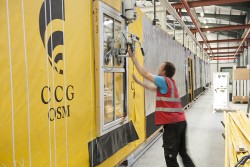The timber industry has long embraced offsite manufacture and is perfectly placed to capitalise on the need for low carbon design and build. David Hopkins, CEO of the UK Timber Trade Federation (TTF) and board member of the Confederation of Timber Industries (CTI) explains further.
It is time for the UK construction industry to level up. The past four decades are evidence that business as usual will not deliver the number of homes which the UK needs, or the high quality, low carbon solutions which we must embrace to reach net zero by 2050. Low productivity, a lack of investment, an ageing workforce and poor planning have all contributed to the average house costing almost eight times what the average Briton earns, and these forces are set to increase the pressure on the traditional model of housebuilding.
Of course, readers of this magazine are aware there are alternatives to timber. Modern methods of construction (MMC) are widely accepted as essential to creating a construction industry and deliver more housing quicker, with a reduced carbon-footprint. The timber industry has long embraced offsite with timber frame construction. It is past time that the effectiveness of offsite is being fully recognised by the government, housing associations, local councils and developers.
Timber should have a natural advantage in this new policy environment. An emphasis on speed creates a preference for offsite, and emphasis on offsite creates a preference for timber. It is a light, versatile material which lends itself to manufacturing processes. However, the UK construction industry remains slow to change. Entrenched practices, low levels of investment into research and development, lobbying by competitors and low productivity have created an industry which is slow to embrace innovation.
As voiced recently by Government-appointed MMC champion Mark Farmer, the volume builder world still views MMC and offsite as unknowns. There is a perception of financial risk, with MMC considered ‘unproven’, and the upfront costs off-putting. I would like to make the point that we can say in the timber industry this is not the case. Structural timber technology is proven, and already accounts for 83% off homes in Scotland, where a healthy, profitable house building industry has thrived for decades.
In England the timber frame accounts for 23% of newbuild homes, a number which grows every year thanks to the many examples of timber frame projects across the UK delivering high quality houses on time and on budget. We listed some in our report with the APPG for the Timber Industries last year on ‘How the timber industries can help solve the housing crisis’. This included an example from the Commonwealth Games, where CCG delivered 700 homes in just 700 days using offsite timber frame construction. A Fabric First approach to construction helped these homes offer top of the line operational efficiency.
It included Accord, one of the largest not-for-profit housing organisations in the Midlands, built its own offsite manufacturing factory in 2011. This factory has grown to the point it now manufactures 1,000 homes per year on a single eight-hour shift per day, while producing less than 3% waste. The report also included Goldsmith Street, a timber frame social housing project in Norwich which won the RIBA Stirling Prize 2019, showcasing how timber frame can create sustainable, affordable, and beautiful housing. This was the largest Passivhaus project in the UK to date.
Each example ties together the benefits of building with timber and using offsite construction. However, the point stands that there are thousands of high-quality homes built using timber frame every year, and the Structural Timber Association (STA) says the capacity already exists to double output.
The greatest beneficiary of a UK-wide switch to timber will be the environment. Trees absorb carbon dioxide before being harvested with many more planted in their place. This carbon is then stored for the duration of the life of this building product, and beyond that if the wood is reused. The timber bio-economy is currently the only viable means of carbon capture and storage, and the Commission of Climate Change (CCC) in the UK has called for the growth of timber construction in place of energy intensive materials as a key means of reducing carbon emissions in construction.
The Biocomposite Centre has found that timber frame homes on average have 20% lower embodied carbon emissions than traditional masonry. Embodied carbon emissions are from construction and materials. This benefit extends to a 60% reduction when cross laminated timber (CLT) is used. We have been discussing many of these benefits with councils, housing associations and architects. For these organisations the writing on the wall is clear, with many making pledges to reduce their carbon emissions. Many councils and architects have pledged to be net zero by 2030.
The demand is there. Clients are calling out for more sustainable, quick construction. It will be up to everyone in the offsite industry to make sure that the solution is obvious. The issues are global, and if we can create a rapid uptake in sustainable materials this industry could become world leading.
Evidence can be seen in the World Green Building Council’s report ‘Bringing Embodied Carbon’, which highlighted the importance of including embodied carbon in sustainable construction, with material and construction causing 11% of global emissions. A similar proportion is echoed in the UK. As the Confederation of Timber Industries we are working to showcase the potential of timber and offsite to industry and policy makers, and we encourage any interested in the low carbon solutions offered by timber to get in touch with us, and to share our news and resources.
For more information visit: www.ttf.co.uk www.cti-timber.org
To view the complete magazine including this article please click here: https://issuu.com/radarcommunications/docs/offsite_mag_issue_22_web/40?e=15424601/64704172









